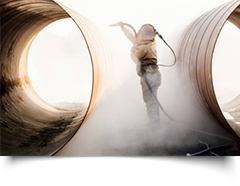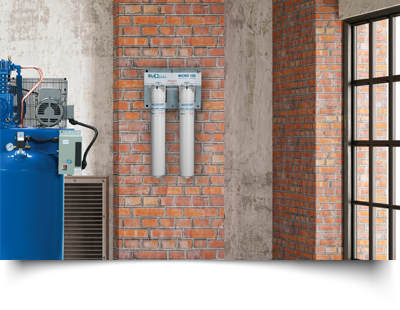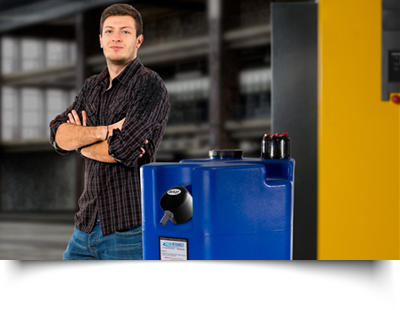Blu Ocean Services—We do it All
Blu Ocean is a full-service Air Energy Optimization & Ecology solutions company offering cradle-to-grave service. We specialize in Compressed Air Systems and Compressor Condensate Management (EPA compliance), Air Assessments, and Energy Savings through new and refurbished compressed air equipment packages.
Whether you have a single 20 HP air compressor or a large compressor room with multiple high HP compressors, we have an aggressive ROI solution to fit your needs. Blu Ocean is your 100% EPA compliance insurance policy.
Ready to get started or have a question? Send a message to a Compressed Air expert today.
Blu Ocean offers 3-levels
of Air Assessments
Tier 1 – No Cost assessment up to 75 HP for a compressor room setup overview. Leak detection optional if rebates are available.
Tier 2 – Rebate sponsored assessment for 100 – 250 HP. Assessment includes data logging equipment and leak detection to reduce system demand and optimize compressed air systems.
Tier 3 – Comprehensive system assessment for 300 HP+ systems. The assessment provides logging equipment and leak detection. This air assessment provides two weeks of onsite system analysis, offering supply and demand-side point of use opportunities to perfect the efficiency of the compressed air system focusing on energy and system efficiency.

Compressed air assessments offer a Process of Discovery using Real-Time Data Loggers and Flow Meters. This equipment can record Amp Draw, Header Pressure, and Compressed Air Flow in any compressed air system over several working days. In addition, an Ultra-Sonic Leak Detector is commonly used during air assessments to identify opportunities to reduce the compressed air demand of the system.
All of this equipment is used in a scientific way to determine the actual compressed air usage during Real-World Production. In addition, the assessment process allows for an analysis of how compressed air is used in the day to day production. This assessment leads to recommendations for Supply and Demand Side changes to improve the system's overall efficiency.
Ultrasonic Leak Detection
An Ultra-Sonic Leak Detector is key in locating detectible and especially non-detectible compressed air leaks. During the leak detection, the leaks are tagged and recorded. Then, the number and size of the leaks are put into an Excel spreadsheet so the cost of each leak can be calculated based on the power draw information pulled from the installed amp loggers.
Assessment Plans
Before the compressed air assessment, a site visit and plant walk-through provide opportunities to put an assessment plan together. Then, in working with the end-user and asking probing questions, the goal is to understand what the end-user hopes to achieve from their perspective. Frequent questions relevant to system costs, final recommendations, and supply and demand projects can be interjected into the assessment to customize the project and match the end-user goals.
Measure Energy Consumption
Real-Time Data Loggers are installed during the air assessment to measure the amp draw from the compressed air system. In addition, pressure loggers are installed to measure header pressure and the pressure swings throughout the production day. Flow meters can also measure low demand and peak demand requirements to help with future planning and system recommendations.
Demand Side
The demand side assessment is unique and separates Blu Ocean's air assessment from basic black box audits and salespeople using air assessments as a sales tool. This study offers the end-user opportunities to reduce their compressed air consumption in the plant.
The demand side assessment is unique and separates Blu Ocean's air assessment from basic black box audits and salespeople using air assessments as a sales tool. This study offers the end-user opportunities to reduce their compressed air consumption in the plant.
On the demand side, we use point-of-use pressure analysis along with point-of-use flow meters. This data collected provides information that can offer alternative ways to deliver the air in a more cost favorable way. One example of demand-side assessments is moving from open-air blows to air knives. Another common demand-side alternative is found with large air one-time events and using surge tanks to satisfy the planned big event.
Supply Side
The supply-side portion of the assessment uses Amp Loggers, Flow Meters, and Pressure Loggers for each shift. The Amp Draw data collection provides real-time power cost analysis. Pressure loggers and flow meters record data to analyze compressor controls, determine the proper configuration, and determine proper storage and management.
Summary Report & Recommendations
All of this equipment is used in a scientific way to determine the actual compressed air usage during Real-World Production. In addition, the assessment process allows for an analysis of how compressed air is used in the day to day production. This assessment leads to recommendations for Supply and Demand Side changes to improve the system's overall efficiency.
Utility Rebate Examples*
| Type | Rate | Rebate Savings Example |
|---|---|---|
| Variable Speed Drive |
$100 per HP replaced | 125 HP VSD x $100 = $12,500 Rebate |
| Cycling Dryer | $1 per CFM | 500 CFM x $1 = $500 Rebate |
| Blower Purge Desiccant Dryer |
$3 per CFM | 800 CFM x $3 = $2,400 |
| No Loss Drains | $100 per drain | 3 No loss drains installed x $100 = $300 |
| Storage Control Flow Controller plus minimum 5 gallons of storage for every CFM |
500 CFM system — 2,500 gallon tank plus flow controller qualifies for $15 rebate per HP | $15 x 100 HP = $1,500 |
| Low Pressure Drop Filter (Mist Eliminator) |
$1 per CFM | 750 CFM Filter x $1 = $750 |
| Heat Recovery (Gas Utility) |
$15 per HP | 100 HP x $15 = $1,500 |
Case Studies

Kalamazoo
When a manufacturing plant hit peak demand, the primary compressor couldn't make enough air, forcing the backup compressor to run.
Read More
Midwest
Bad data on air usage and missed load leaks nearly cost this manufacturer downtime and money for additional equipment.
Read More
Michigan
Inefficient use of supply and demand-side air costs a small shop more than $100,000 annually in electricity.
Read More



